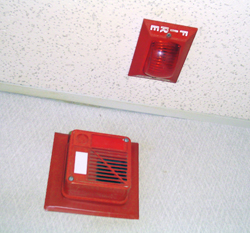
They will have to work with sound system designers and commissioners one way or another.
The new section of 2010 NFPA 72 that primarily deals with this issue is Chapter 24: Emergency Communications Systems (ECS). Chapter 24 (Figure 1) addresses several approaches to ECS:
• One-way communications ECS
• Two-way communications ECS
• Information command and control for ECS
• Performance-based design for ECS
The sections that require intelligible voice announcements are two one-way communications ECS types: fire Emergency Voice/Alarm Communications Systems (EVACS) and Mass Notification Systems (MNS).
The difference between them is that the EVACS system is designated for fire alarm use, generally in high rise buildings. It allows for zoned fire alarm areas to be selected for evacuation or as a safe haven depending on the situation.
Risk Assessment
The MNS is intended for use in addition to a fire alarm system, or for non-fire emergencies such as tornadoes, earthquakes or terrorist attacks.
A new building is required to have an MNS if it is deemed necessary by the “risk assessment” process, which is defined within the code.
Given particular requirements, the code allows a building’s paging or sound reinforcement system to be used as it’s MNS, since, by their nature, PA systems are generally designed with intelligible speech in mind.
The fire code allows for a fire EVACS system to do double-duty as an MNS system, but because the fire EVACS function is the fire alarm system’s annunciation, an MNS system does not meet the requirements for that function and therefore cannot be used for both functions.
Because of this, a PA system used as an MNS does not have to meet the typical requirements for fire alarm equipment.
However, there is a lot of confusion about the new code for those fire jurisdictions that have adopted the 2010 version.
Many fire marshals, or AHJ’s (Agents Having Jurisdiction), are not yet clear about this new section of the code, particularly if they have just adopted it, and even more, are not yet certain about the particular requirements for intelligible announcements.
Note that the new code does not immediately have to be adopted by all fire jurisdictions, which can choose to stay with an older version of the code.
Check with your local fire marshal to find out if the new code applies in your area.
For those interested in this new market potential, I recommend purchasing the 2010 NFPA 72 National Fire Alarm and Signaling Code Handbook from the National Fire Protection Association website and investing the time to study it. It costs about $130 with shipping.
My next installment will discuss exactly how to measure sound system intelligibility in order to comply with the new fire code.
John Murray is a 34-year industry veteran who has worked for several leading manufacturers, and has also presented two published AES papers as well as chaired numerous SynAudCon workshops. He is currently the principal of Optimum System Solutions, a consulting firm.

